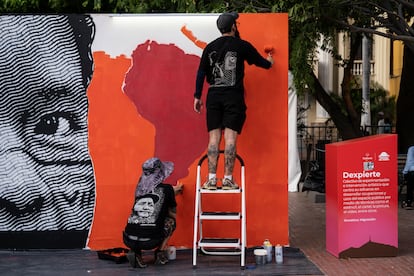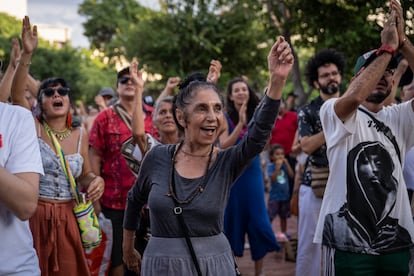“Santa Marta, Santa Marta has a train, Santa Marta has a train, but it doesn’t have a tram,” says an age-old song about the Colombian city. Today that same Caribbean port could say it has a summit but not a good airport. The 600,000 inhabitants of the capital of the Magdalena department will receive this Sunday a dozen heads of state and a similar number of chancellors from the 27 countries that make up the European Union and the 33 that make up the Community of Latin American and Caribbean States, CELAC. But the town, famous for its beaches and the splendid Sierra Nevada that frames its bay, is on all fours to welcome him. Clear proof: on Friday evening the president of the Spanish government, Pedro Sánchez, was unable to arrive at his airport. His plane had to fly to nearby Barranquilla, where he was officially received, and then take a Colombian military plane to take him to his destination.
“They’re doing everything last minute,” explains a taxi driver at midday Friday, two days before the session. He points to several construction machinery operators. “Now they enjoy the fresh air (the thermometer reads 26 degrees, with a thermal sensation of 40), when the sun sets they will do those little things again so that the street looks better.” It refers to the wide road, with two lanes in each direction, which connects the airport with the center of the city founded 500 years ago by the Spaniard Rodrigo de Bastidas.
Halfway between the two points lies the Estelar Santamar, a hotel that will host the official summit this Sunday in its conference center. On Friday at 5pm you can still see several teams of workers arranging the details to have everything ready in time: the delegations will have to arrive this Sunday between 8 and 9 am. Santa Marta, and the Colombian government that hosts it, want to show off.
But not only with presidents, prime ministers or chancellors. Even with people. It is not in vain that Colombian President Gustavo Petro chose the city as the venue for the summit. True to his style, he underlined the symbolism of the convocation in the oldest city among those founded by European colonizers in present-day Colombia, where Simón Bolívar died 195 years ago, where the left to which he belongs took power from the traditional political class 13 years ago. It is “the heart of the world,” he has repeatedly said, referring to the worldview of the indigenous Kogi people, who live in the mountains and before whom he took the oath before taking office during the official inauguration. “We brought 60 delegations to this place, one of the most beautiful in the world, anthropologically, geographically, energetically and scientifically, we are in the heart of the world”, celebrated the president, to close with another of his slogans. “Colombia, the country of beauty.”



With this vision, the government developed a parallel agenda that reached the city’s 600,000 inhabitants. Its Ministry of Culture, in alliance with the Mayor’s Office and the Government of the Department, developed between Friday and Saturday what it called “Reunion in the heart of the world”, a series of concerts, conversations or film screenings that wink at the critical vision of the colony with which the Nation approached the half millennium of the city, in open contrast with a more commemorative vision of the Mayor’s Office.
On Friday and Saturday, an urban center filled with backpackers and families tired of long hours in the sun received scholarly conversations like the one titled The decolonial turnin which the director of the National Archives, Francisco Flórez, moderates the philosophers Laura Quintana and Santiago Castro Gómez. At the same time, and until late at night, in the streets and squares such as Parque Bolívar or the median on the bay, Samarios and visitors trembled with artists such as the Puerto Rican Andy Montañez, the Dominican Vicente Martínez or the Colombian Nidia Góngora. Faithful to the Caribbean spirit, the summit is also a party.
The city also becomes the scene of other meetings, starting with the summit, events which lead to saturation of its hotel capacity. One is the business forum which will concentrate its activity throughout Sunday and which was convened by the EU, the Colombian government, CAF and the IDB group in a hotel in the same tourist area as the summit.
Another is the Civil Society Forum of Latin America, the Caribbean and the European Union, which between Friday and Saturday received the Commissioner for Equity of the European Commission, Hadja Lahbib; Oxfam’s Americas and Caribbean director, Gloria García Parra; or the Deputy Minister of Multilateral Affairs of Colombia, Mauricio Jaramillo. Between the two, dozens of companies, organizations and entities from Europe or Latin America sent representatives who stayed there or at other compounds on a long beach that runs from the airport to downtown, and where busy officials mingled with retirees or summer families this weekend.



